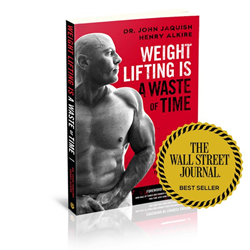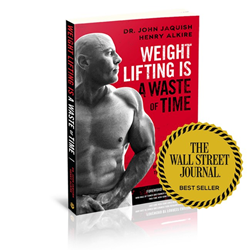
WSJ Bestselling book, Weightlifting is a Waste of Time – So is Cardio
It’s safe to say most women want to be leaner and healthier, and not fatter and more prone to heart problems. Variable resistance is a proven method of achieving these goals. John Jaquish, Ph.D.
SAN FRANCISCO (PRWEB)
October 18, 2022
Suddenly, seemingly out of nowhere, menopause symptoms can strike women, resulting in uncontrollable weight gain, hot flashes, night sweats, exhaustion, and muscle and bone density loss. Dr. John Jaquish, scientist, inventor, and author of the WSJ Bestselling book, Weightlifting is a Waste of Time – So is Cardio explains how variable resistance exercise is a highly effective approach for building muscle, losing fat, and producing a number of other essential benefits that can help women overcome menopause and post-menopausal symptoms.
Variable resistance exercise utilizes elastic bands to vary the resistance (tension on the muscle) as we perform an exercise. The resistance is lightest at the beginning of the repetition and heaviest at the end of the repetition. Variable resistance band training places less stress on joints (where we are weakest) and more stress at points in the range of motion where we are strongest, maximizing workout effectiveness and minimizing the risk of injury.
“A 2018 study of 38 post-menopause women showed training with variable resistance not only significantly lowered weight and waist circumference but also improved cardiovascular profiles and cholesterol indicators. The control group that didn’t do any exercise over the same one-year period showed significant increases in their weight and waist circumference,” said Dr. Jaquish.
Variable resistance offers many health benefits and here are five that particularly help women experiencing menopause and post-menopause symptoms:
- Boosts Metabolism. It is not only the best way to enhance body composition but the more muscle, the faster the metabolism This means burning calories at a greater rate, even by just breathing.
- Reduces Risk of Heart Disease. In the United States, heart disease is the leading cause of death for women but also the most preventable. Variable resistance improves heart health by decreasing blood pressure and reducing plasma triglycerides. Furthermore, strength training may be more beneficial for heart health than dynamic or cardio exercise.
- Promotes Mental Health. A meta-analysis of 33 clinical trials found that strength training corresponds with a reduced risk of depression. Resistance training also reduces instances of anxiety.
- Builds Self-Esteem. When women are physically stronger, they’re more confident, independent, and resilient. A 2013 study found that women who strength train have a more positive body image and report greater fulfillment in life resulting in an improved sense of self-worth.
“It’s safe to say most women want to be leaner and healthier, and not fatter and more prone to heart problems. Variable resistance is a proven method of achieving these goals. But the real takeaway is, women can effectively strength train with little to no risk of injury and get these benefits with variable resistance,” said Dr. Jaquish.
The book is packed with research, studies, and details on the better way to have a strong lean body and good health.
For more information about Dr. Jaquish and to order the book Weightlifting is a Waste of Time – So is Cardio, visit doctorj.com
About John Jaquish, PhD
Scientist, inventor, and author John Jaquish, PhD. has spent years researching and developing improved approaches to health. He is the inventor of the bone density-building medical technology OsteoStrong and the creator of the variable resistance X3 exercise system for accelerated muscle development. Dr. Jaquish’s methods are used in training the world’s most elite athletes, including the Miami Heat, various NFL and NBA players, MMA champions, and members of the US Olympic team. His book, Weightlifting is a Waste of Time – So is Cardio, explains his non-conventional approach to human physiology and is a WSJ Bestseller
Share article on social media or email:

